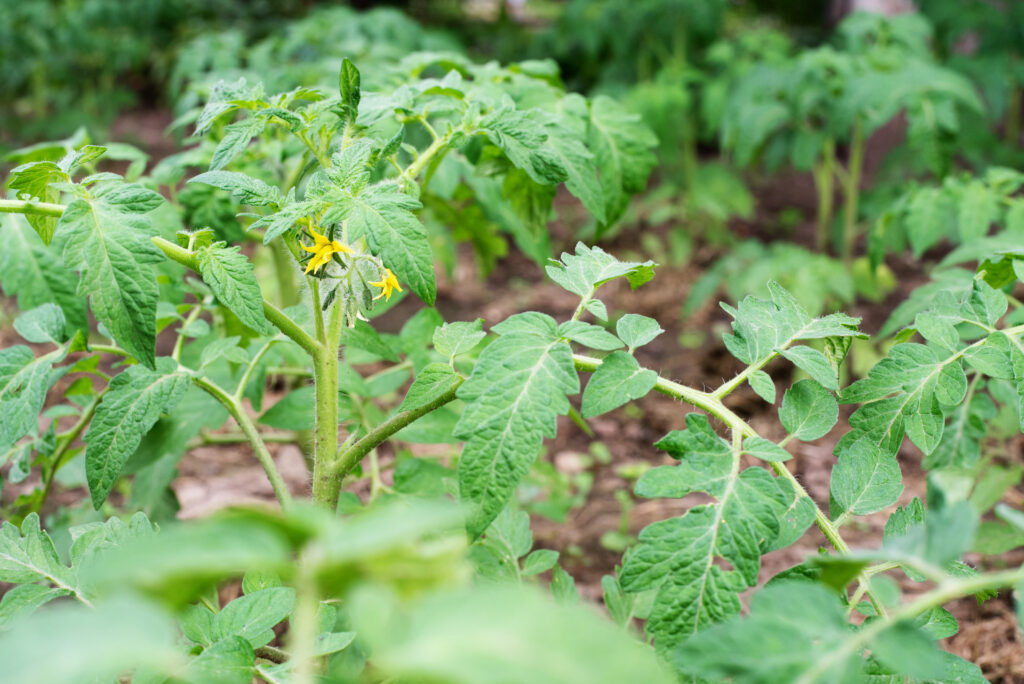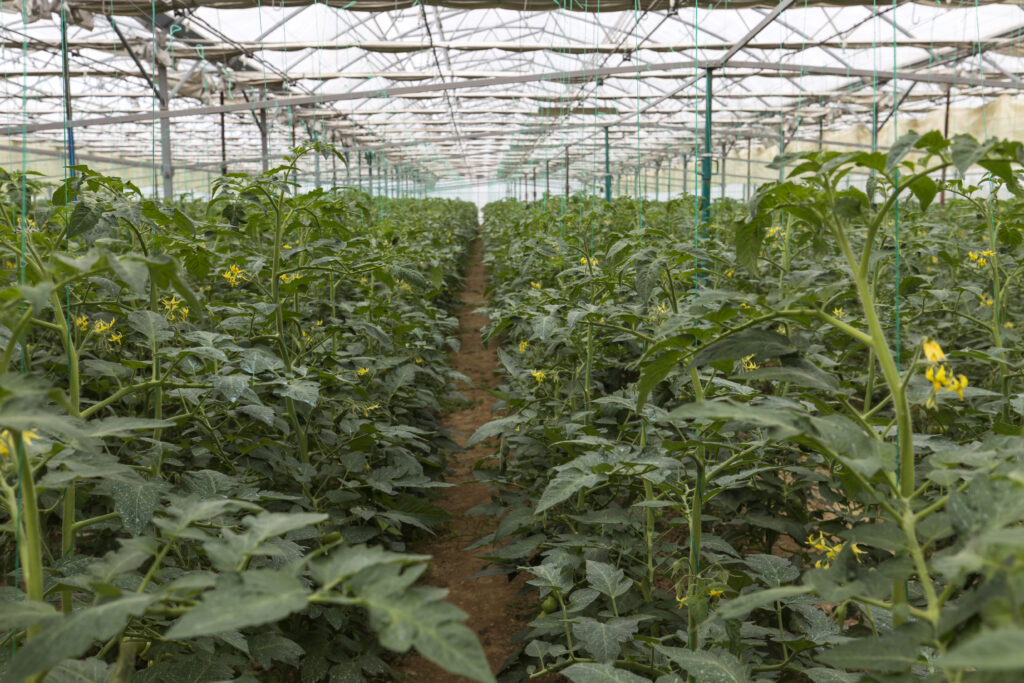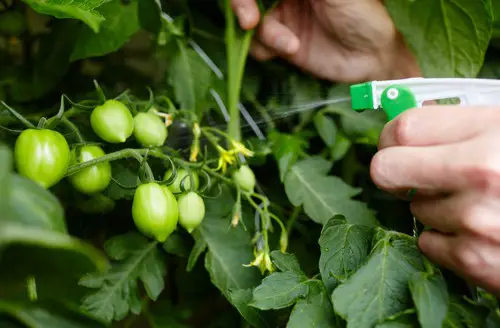Tomatoes are a staple in many home gardens, but white spots on tomato leaves can be a frustrating issue for gardeners. These spots can be caused by a variety of factors, including fungal infections, pests, and environmental stressors.
While there are commercial fungicides available, many gardeners prefer to use natural home remedies to treat white spots on tomato leaves.
Understanding the causes of white spots on tomato leaves is crucial for effective treatment. Fungal infections such as powdery mildew and late blight are common culprits, as are pests like stinkbugs.
Environmental stressors like water stress and insufficient sunlight can also lead to white spots on tomato leaves. Recognizing the symptoms and signs of these issues can help gardeners take the appropriate preventive measures and choose the most effective home remedies.
Effective home remedies for white spots on tomato leaves include treatments like neem oil, baking soda spray, and milk spray. These natural remedies can help control fungal infections and repel pests without the use of harmful chemicals.
Preventive measures like proper watering, adequate sunlight, and good air circulation can also help keep tomato plants healthy and prevent white spots on leaves.
By understanding the causes of white spots on tomato leaves and using natural home remedies, gardeners can maintain healthy tomato plants and enjoy a bountiful harvest.
Key Takeaways on Home Remedy for White Spots on Tomato Leaves
- Understanding the causes of white spots on tomato leaves is crucial for effective treatment.
- Effective home remedies for white spots on tomato leaves include natural treatments like neem oil, baking soda spray, and milk spray.
- Preventive measures like proper watering, adequate sunlight, and good air circulation can help keep tomato plants healthy and prevent white spots on leaves.
Check out these other related posts:
- White Spots on Hibiscus Leaves
- White Spots on Fukien Tea Bonsai Leaves
- Ficus Tree Leaves Covered in White Spots
Understanding White Spots on Tomato Leaves

White spots on tomato leaves are a common issue that many gardeners face. These spots can be caused by a variety of factors, including fungal diseases, insect infestations, and weather damage. Understanding the causes of white spots on tomato leaves is key to treating and preventing this issue.
One of the most common causes of white spots on tomato leaves is powdery mildew, which is a fungal disease. Powdery mildew typically appears as a white or gray powder on the leaves of the tomato plant. It can be caused by a variety of factors, including high humidity, poor air circulation, and warm temperatures.
Another potential cause of white spots on tomato leaves is leaf mold, which is also a fungal disease. Leaf mold typically appears as yellow or brown spots on the leaves of the tomato plant, which can eventually turn white. This disease is often caused by high humidity and poor air circulation.
Bacterial spot is another potential cause of white spots on tomato leaves. This disease is caused by a bacterial infection and typically appears as white or yellow spots on the leaves of the tomato plant. Bacterial spot can be caused by a variety of factors, including high humidity, poor air circulation, and warm temperatures.
Insect infestations can also cause white spots on tomato leaves. For example, spider mites can cause white spots on the leaves of the tomato plant by sucking the sap out of the leaves. Similarly, whiteflies can cause white spots on the leaves of the tomato plant by feeding on the plant’s sap.
Finally, weather damage can also cause white spots on tomato leaves. For example, sunscald can cause white spots on the leaves of the tomato plant by burning the leaves. Similarly, hail damage can cause white spots on the leaves of the tomato plant by damaging the leaves.
Common Diseases Leading to White Spots
White spots on tomato leaves can be caused by a variety of diseases, including fungal infections, powdery mildew, late blight, alternaria, and septoria leaf spot. Fungal diseases are the most common cause of white spots on tomato leaves, and they can be difficult to control once they take hold.
Powdery mildew is a fungal disease that is often carried by air currents and insects such as aphids. It is most prevalent when the temperatures are hot and dry or hot and humid for an extended period. Powdery mildew can cause white spots on tomato leaves, as well as distorted growth and reduced fruit production.
Late blight is another fungal disease that can cause white spots on tomato leaves. It is a serious disease that can quickly spread through a garden and destroy entire tomato crops. Late blight causes white spots on the leaves, as well as dark spots on the fruit.
Alternaria is a fungal disease that can cause white spots on tomato leaves, as well as brown spots on the fruit. It is often spread by water splashing on the leaves and can be difficult to control once it takes hold.
Septoria leaf spot is a fungal disease that can cause white spots on tomato leaves, as well as brown spots with yellow halos. It is often spread by water splashing on the leaves and can be difficult to control once it takes hold.
Recognizing Symptoms and Signs

Tomato plants are susceptible to various diseases and pests that can cause white spots on their leaves. These white spots can indicate several issues, including fungal infections, nutrient deficiencies, and pest infestations.
It is important to recognize the symptoms and signs of white spots on tomato leaves to determine the underlying cause and apply appropriate remedies.
1. White Spots
White spots on tomato leaves are a common symptom of fungal infections such as powdery mildew and late blight. Powdery mildew appears as white, powdery spots on the leaves, stems, and fruit of the tomato plant.
Late blight, on the other hand, causes irregular white spots that eventually turn brown and cause the leaves to curl and die.
2. Leaf Spots
Leaf spots are another common symptom of fungal infections. These spots appear as small, circular lesions on the leaves, which can turn yellow or brown over time. Leaf spots can be caused by several fungal pathogens, including Septoria leaf spot, early blight, and bacterial spot.
3. Curling
Curling of tomato leaves is a common symptom of several issues, including nutrient deficiencies, pest infestations, and fungal infections. Curling can be caused by a lack of water, high temperatures, or damage to the roots. Pest infestations such as spider mites can also cause curling of the leaves.
4. Dried Leaves
Dried leaves on tomato plants can indicate several issues, including overwatering, underwatering, and nutrient deficiencies. Overwatering can cause the leaves to turn yellow and then brown, while underwatering can cause the leaves to dry up and fall off. Nutrient deficiencies can also cause the leaves to dry up and turn brown.
5. Fruit
White spots on tomato fruits can indicate several issues, including fungal infections and pest infestations. Fungal infections such as blossom end rot can cause white spots on the bottom of the tomato fruit, which can eventually turn black and cause the fruit to rot.
Pest infestations such as stink bugs can also cause white spots on the tomato fruit.
6. Stems
White spots on tomato stems can indicate several issues, including fungal infections and pest infestations. Fungal infections such as verticillium wilt can cause white spots on the stem, which can eventually turn brown and cause the plant to wilt. Pest infestations such as cutworms can also cause white spots on the stem.
7. Blister
Blister on tomato leaves can indicate several issues, including sunscald and pest infestations. Sunscald can cause blister-like lesions on the leaves, which can eventually turn brown and cause the leaves to die. Pest infestations such as flea beetles can also cause blister-like lesions on the leaves.
Preventive Measures Against White Spots

Preventive measures are the best way to avoid the appearance of white spots on tomato leaves. Here are some tips to help prevent white spots from appearing:
1. Pruning
Pruning tomato plants is an effective way to prevent the spread of powdery mildew, which is a common cause of white spots on tomato leaves. Pruning infected leaves will prevent the spread of the disease to other parts of the plant. It will also improve air circulation, which helps prevent the growth of powdery mildew in the future.
2. Air Circulation
Proper air circulation is essential for preventing the growth of powdery mildew. Poor air circulation can cause humidity to build up around the plants, which creates an ideal environment for the growth of powdery mildew. Ensure that the tomato plants are spaced out properly to allow air to circulate freely around them.
3. Sunlight
Tomato plants need plenty of sunlight to grow properly, but too much direct sunlight can also cause problems. Direct sunlight can cause the leaves to become scorched, which can lead to the appearance of white spots. Ensure that the tomato plants are getting the proper amount of sunlight to prevent this problem.
4. Watering
Proper watering is essential for the health of tomato plants. Overwatering can cause the soil to become waterlogged, which can lead to the appearance of white spots. Use drip irrigation or water the soil around the plants instead of watering the leaves directly. This will help prevent the growth of powdery mildew on the leaves.
5. Humidity
High humidity levels can also cause the appearance of white spots on tomato leaves. Ensure that the tomato plants are not in an area with high humidity levels. If the humidity is too high, consider using a dehumidifier or moving the plants to a drier location.
6. Temperature
Temperature can also play a role in the appearance of white spots on tomato leaves. Cold temperatures can cause the leaves to become damaged, which can lead to the appearance of white spots. Ensure that the tomato plants are not exposed to cold temperatures.
7. Spacing and Transplanting
Proper spacing and transplanting of tomato plants can also help prevent the appearance of white spots. When transplanting tomato plants, ensure that they are not overcrowded. Overcrowding can lead to poor air circulation, which can cause the appearance of white spots.
8. Harden Off
Harden off tomato plants before transplanting them into the garden. This process helps the plants adjust to the outdoor environment gradually. Harden off the plants by gradually exposing them to outdoor conditions over a period of several days.
Home Remedies for White Spots on Tomato Leaves

White spots on tomato leaves can be caused by a variety of factors, including fungal or bacterial infections, pests, or nutrient deficiencies.
While chemical treatments are available, many gardeners prefer to use natural home remedies to avoid exposing their plants to potentially harmful chemicals. Here are a few effective home remedies for white spots on tomato leaves:
Neem Oil
Neem oil is a natural insecticide and fungicide that can be used to treat a variety of plant diseases, including white spots on tomato leaves. To use neem oil, dilute it with water according to the package instructions and spray it on the affected leaves. Repeat the treatment every 7-14 days until the white spots disappear.
Milk Spray
Milk is another natural remedy that can be used to treat white spots on tomato leaves. Mix one part milk with two parts water and spray it on the affected leaves. The proteins in the milk will help to fight off the fungal or bacterial infection causing the white spots. Repeat the treatment every 7-10 days until the white spots disappear.
Baking Soda Spray
Baking soda is a natural fungicide that can be used to treat white spots on tomato leaves. Mix one tablespoon of baking soda with one quart of water and spray it on the affected leaves. The baking soda will help to kill the fungus causing the white spots. Repeat the treatment every 7-10 days until the white spots disappear.
Nutrient Deficiencies
White spots on tomato leaves can also be caused by nutrient deficiencies. To prevent nutrient deficiencies, make sure your plants are getting enough fertilizer and compost. Tomatoes need a lot of calcium and magnesium, so consider adding a calcium and magnesium supplement to your soil. Copper is also important for tomato health, so consider using an organic copper fungicide to prevent white spots on tomato leaves.
Other Factors Affecting Tomato Plants
Besides white spots caused by diseases or pests, there are other factors that can affect tomato plants. These factors can impact the yield, taste, and overall health of the plant.
One factor that can affect tomato plants is the lack of nutrients. Tomato plants require a variety of nutrients to grow and produce fruit. A lack of nutrients can lead to stunted growth, poor fruit development, and nutrient deficiencies.
Gardeners can prevent this by ensuring their tomato plants are planted in nutrient-rich soil and fertilizing regularly.
Another factor that can impact tomato plants is wind. Strong winds can damage the plant and cause it to lose leaves or fruit. Gardeners can protect their plants from wind damage by providing a windbreak or staking the plant.
Sunscald is another issue that can affect tomato plants. This occurs when the fruit is exposed to too much direct sunlight, causing it to become discolored or even cracked.
Gardeners can prevent sunscald by providing shade for the plant during the hottest parts of the day.
Root rot is a common issue that can affect mature tomato plants. This occurs when the roots are exposed to too much water, leading to fungal growth and decay. Gardeners can prevent root rot by ensuring their plants are not overwatered and that the soil has proper drainage.
In addition to these factors, there are also pests such as aphids, whiteflies, spider mites, and mealybugs that can impact tomato plants. Gardeners can prevent these pests by regularly inspecting their plants and using natural pest control methods such as neem oil or insecticidal soap.
Finally, the variety of tomato plant can also impact the taste and overall health of the plant. Some varieties are better suited for greenhouse growing, while others are better suited for outdoor gardens. Gardeners should choose a variety that is well-suited for their specific growing conditions and desired taste.
Conclusion: Maintaining Healthy Tomato Plants

Maintaining healthy tomato plants is crucial to prevent the occurrence of white spots on tomato leaves. Proper care and attention can help prevent and treat the issue. In this section, we will discuss some tips on how to keep your tomato plants healthy and prevent white spots on tomato leaves.
Growing Tomatoes
Growing tomatoes require proper care and attention. Here are some tips to help you grow healthy tomato plants:
- Choose a sunny location: Tomato plants require at least 6-8 hours of full sunlight a day. Make sure to choose a sunny location to grow your tomato plants.
- Proper spacing: Tomato plants require proper spacing to grow properly. Aim for 18-24 inches apart for the best results.
- Watering: Water the soil and avoid getting the leaves wet. Wet leaves can attract fungus and spread the disease. A drip irrigation system is ideal to grow tomatoes.
- Fertilizing: Proper fertilization can help your tomato plants grow healthy. Use a balanced fertilizer and follow the instructions on the package.
Treatment for White Spots on Tomato Leaves
White spots on tomato leaves can be treated by following these tips:
- Pruning: Pruning your tomato plant encourages growth, but it can also be used as a treatment against powdery mildew. Pruning the infected leaves will prevent the powdery mildew from spreading to other parts of the plant. It will also improve air circulation and help prevent the growth of powdery mildew in the future.
- Fungicides: Fungicides can be used to treat white spots on tomato leaves. Make sure to use a fungicide that is labeled for use on tomato plants and follow the instructions on the package.
Prevention
Preventing white spots on tomato leaves requires proper care and attention. Here are some tips to help prevent the issue:
- Proper spacing: Proper spacing can help prevent the occurrence of white spots on tomato leaves. Aim for 18-24 inches apart for the best results.
- Watering: Water the soil and avoid getting the leaves wet. Wet leaves can attract fungus and spread the disease. A drip irrigation system is ideal to grow tomatoes.
- Fertilizing: Proper fertilization can help prevent the occurrence of white spots on tomato leaves. Use a balanced fertilizer and follow the instructions on the package.
- Air circulation: Proper air circulation can help prevent the growth of powdery mildew. Make sure to space your tomato plants properly and prune them regularly to improve air circulation.
Frequently Asked Questions
What causes white spots on tomato leaves?
White spots on tomato leaves are often caused by fungal diseases, such as powdery mildew or early blight. These diseases thrive in warm and humid environments and can spread quickly if not treated promptly.
How can I get rid of white spots on tomato leaves?
There are several ways to get rid of white spots on tomato leaves. One effective method is to treat the affected plants with neem oil or a commercial fungicide that is safe for use on edible plants.
Bio-fungicides are also useful tools to get rid of the disease without infecting the plant with any dangerous chemicals. It is important to cut away any diseased parts of the plant and destroy them to prevent the disease from spreading.
Are white spots on tomato leaves harmful?
White spots on tomato leaves can be harmful if left untreated. They can cause the plant to weaken, become stunted, and produce fewer fruits. Additionally, fungal diseases can spread to other plants in the garden, leading to a larger problem.
What is the best home remedy for yellow spots on tomato leaves?
One effective home remedy for yellow spots on tomato leaves is to mix one tablespoon of baking soda with one gallon of water and spray the affected plants. This solution can help to prevent the spread of fungal diseases and improve the overall health of the plant.
How do I prevent white bugs from infesting my tomato plants?
One effective way to prevent white bugs from infesting tomato plants is to keep the garden clean and free of debris. Additionally, using natural insect repellents, such as neem oil or garlic spray, can help to deter pests from the garden.
Can I use baking soda to treat white spots on tomato leaves?
Yes, baking soda can be an effective treatment for white spots on tomato leaves. Mix one tablespoon of baking soda with one gallon of water and spray the affected plants. This solution can help to prevent the spread of fungal diseases and improve the overall health of the plant.

